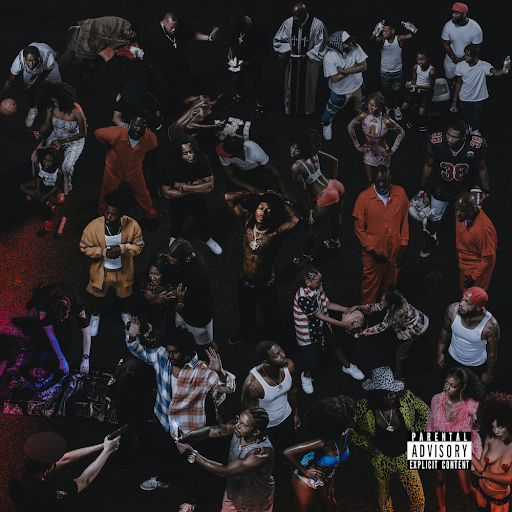JID released “The Forever Story,” a sequel to his debut “The Never Story,” on Aug. 26. Known for his clever wordplay and reputation for entertaining feature-verses, the Atlanta rapper has made a name for himself within circles of lyric-conscious listeners. With his appreciation of the music’s history and its humble beginnings, JID carries on an important role in hip-hop: the classicist.
Hip-hop is, at its core, spoken poetry over the fragmented instrumental of a DJ’s scratching and was created as a result of the ingenuity of Black New York City youth in the ’70s. DJs engineered technology to transition between songs, queue tracks and physically scratch a record to create a distinct sound. This new art developed further when, at parties, attendees began rhyming over the DJ’s beats. With this innovation, hip-hop’s most essential dynamic was formed. The rapper, or MC, was tasked with “moving the crowd” while the DJ backed up the rhymes with energetic beats.
Since then, hip-hop has changed as an art form. Revolutionary artists like Tyler, the Creator and Mac Miller have pushed boundaries for what being a rapper entails, allowing topics like mental health and queer identity into a genre known for its bravado and stoicism. While these progressions have inarguably made the genre more accessible and diverse in sound, they sometimes move away from the invented style championed for decades. However, a select few have managed to find varying degrees of mainstream success while utilizing the simple yet beautiful combination of sounds made famous by hip-hop’s pioneers. In his new album, JID attempts to be among them. The album projects his best first week album sales to date, so he seems to be succeeding.

Courtesy of Dreamville.
Two of the most incredible moments on “The Forever Story” revolve around the inclusion of a classic artist. On “Surround Sound,” a high-energy, dense track, JID samples the legendary Mos Def, aka Yasiin Bey. The sample gives a nostalgic tone to an otherwise contemporary track, thanks to Bey. In hip-hop, there are few figures more respected than Mos Def, as his work in the rap underground has served as inspiration for several generations. On “Stars,” JID features Bey himself. The track allows JID to examine an alternative style to that on “Surround Sound,” matching Bey’s old-school lyricism and flows. This feature is a truly special moment, and a rare cosign from a highly respected musical icon.
JID shows off his lyrical ability throughout the album, especially on “Dance Now,” applying multiple meanings to several lines in the song. For example, he raps:
“Lemme bear it all when I’m tellin’ God,
You know I’ma rant when I talk to Jah”
Here, he ties religious and cultural references into the lyrics all at once. The lines at face value refer to the Christian God “Yahweh” or Jehovah, often dubbed as “Jah” in Rastafarianism. However, when examined, “I’ma rant” can sound like “I’m Morant,” in reference to Memphis Grizzlies’ basketball All-Star Ja Morant. Under even more scrutiny, a listener may realize that JID claims to “bear it all,” perhaps doubly referencing the Grizzlies’ mascot. This level of written complexity adds a layer of meaning to the music, emphasizing JID’s ability to lead album production with his writing rather than hiding behind over-complicated instrumentals.
JID’s intriguing rapping capabilities on “The Forever Story” does not mean that there are not other rappers doing boom bap hip-hop better. Notably, rap duo Run The Jewels has released four albums in which their old-school take on modern rap holds my attention longer than JID does. I would be remiss not to also honor the late Nipsey Hussle, a California artist whose album “Victory Lap” won the hearts of rap fans while staying true to hip-hop’s roots. Compared to these top notch lyricists or ’90s and ’00s legends like Common, the Wu-Tang Clan and Jay-Z, I have a hard time hearing JID’s work as especially novel.
JID clearly sees himself as an artist carrying on the prophetic, wise role embodied by his more senior contemporaries such as Lupe Fiasco, J. Cole and Kendrick Lamar. My most critical commentary on this goal is not in his intentions; seeing an ambitious artist attempting to make a difference through his music should inspire any listener. However, Cole and Lamar’s wisdom and fatherly role in the hip-hop landscape come from years of meticulous, competitive domination and slow maturing through intentional work. While I can’t applaud JID’s visions of influence enough, I believe some time and improvement is required before he can reach the heights of the modern greats.
Despite my criticisms of JID’s evolution and his current endeavors, the best moment of “The Forever Story” comes as the pleasant weight of the first half of the album reaches the record’s fulcrum, beginning to tip toward a more conscientious second run. As the album’s tone begins to shift, we are gifted “Kody Blu 31,” JID’s take on a resilience anthem similar to Kendrick Lamar’s 2015 “Alright.” As the outer clay is further chiseled away, all that is left is a minimal drum, bass and brass instrumental and JID’s unaltered voice. An extremely personal and intimate cut, the artist tells the story of a friend’s son who passed away at a young age. In a sincere tone, JID encourages his friends to keep moving forward through hardship or to “keep swangin’ on.” One can’t help but to be moved by this commentary, as in the face of difficult times, I find that art serves a better escape than any pit of darkness or distraction. In JID’s attempts to move his crowd, he succeeds in valiant fashion, albeit differently than poets of the past.
With “The Forever Story,” JID continues his pursuit of cultural importance as well as his search to distinguish his sound from his contemporaries. He never fails in his regards to the innovators of the past, always choosing to honor the artists that came before him. At times, his charisma can be lost in the depths of the lyrical labyrinths through which we are ushered, but his genuine love for the art he releases always shines bright. While I hope to see JID continue his growth as a cultural figure and an MC, for now I will keep “swangin’ on” with him.
Ben Brodsky (he/him) (25B) is from Scottsdale, Arizona. He has explored hip-hop history since 2019, first on his blog SHEESH hip hop, and now with “Hip Hop Heroes,” a series of essays on narrative in hip-hop. When not writing about Jay-Z, you can find him writing “Brodsky in Between,” an Opinion column on political nuance, graphic designing and playing basketball.






